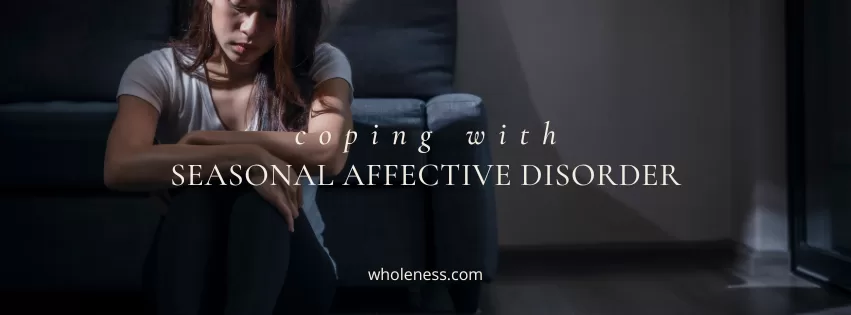Coping with Seasonal Affective Disorder

How to Cope with Seasonal Affective Changes: Embrace the Shift and Nourish Your Mind and Body
As the seasons change, it’s natural for your mood and energy levels to fluctuate. The Earth’s tilted axis causes different parts of the world to receive varying amounts of sunlight, creating seasonal transitions. These shifts can affect us both physically and mentally, leading to conditions like Seasonal Affective Disorder (SAD). However, there are many ways to embrace these changes and care for your mental and physical health through this time.
Meditation and Reflection: Embrace the Shift
Let’s take a moment to appreciate the present. The Earth is turning, and with that, the seasons change. As we enter fall and winter, the days grow shorter, and many of us notice a shift in mood and energy. It’s important to reflect on this and tune inwards. The seasonal changes are an opportunity to slow down, rest, and reflect rather than push for constant productivity. Think of it as a time to “settle down” and focus more on inner peace and self-care.
Working with the Seasonal Changes
Learning to work with, not against, the changes is the key to navigating seasonal shifts. If you notice you’re feeling more tired, introspective, or disconnected, that’s okay. These are natural parts of the seasonal rhythm. Consider adopting Hygge—the Danish concept of coziness and contentment. Create a warm and inviting space to relax, and make time for quiet moments of self-reflection or mindfulness.
Seasonal Affective Disorder (SAD) and Treatments
For many, seasonal changes can bring about feelings of sadness, fatigue, and a lack of motivation. Research shows that Seasonal Affective Disorder (SAD) often peaks in the winter months due to reduced sunlight exposure. In addition to SAD, conditions like ADHD and PMDD can also worsen during the colder months. The good news? These conditions, along with SAD, can often be managed effectively with light therapy.
Light Therapy: A Proven Solution
Light therapy has been shown to improve symptoms of SAD, ADHD, and PMDD by mimicking sunlight. However, it’s essential to use light therapy correctly to see results:
- Timing: Light therapy is most effective when used early in the morning before sunrise. It helps reset your circadian rhythm and signals to your brain that it’s “daytime.”
- Intensity: Make sure your lightbox provides at least 200 square inches of light exposure. Smaller lightboxes may be less effective.
- Distance and Angle: Keep a distance of 16-24 inches from the lightbox, and ensure the light mimics natural sunlight by coming from above and angling downward.
Start with 10-15 minutes of light exposure, gradually increasing to 20-30 minutes, and be patient—results can take up to two weeks.
Supporting Your Body: Exercise and Nutrition
Along with light therapy, maintaining a healthy routine is essential. Exercise is crucial to combat fatigue and improve mood. Pairing your light therapy with physical activity can boost energy and motivation.
As the weather cools, many people crave heavier, denser foods, which can leave you feeling sluggish. To balance this, opt for lighter meals that are easy to digest—think roasted vegetables, butternut squash soup, or veggie bowls. Warming spices like cinnamon, ginger, and rosemary taste great and can stimulate circulation, improve digestion, and lift your mood.
Adaptogens: Natural Support for Mood and Energy
During the colder months, adaptogens like Rhodiola can be a helpful addition to your routine. Historically used in cold climates, this herb supports mood, energy, and stamina, helping you power through winter’s darker days. Pairing Rhodiola with mitochondrial support like CoQ10 can provide an extra boost.
Addressing Grief and Emotional Well-being
For some, the holiday season brings up feelings of grief or loss. If the season brings up difficult emotions, it’s important to acknowledge them early. Combining herbs like Hawthorne with Rhodiola can offer both heart and head support. Therapy is also an essential tool for processing grief and navigating complex emotions.
Regulate Blood Sugar and Avoid the Sugar Rush
With the winter months come plenty of indulgences, especially around the holidays. Blood sugar regulation is key to avoiding mood swings, irritability, and energy crashes. Consider focusing on protein-rich meals to stabilize blood sugar and avoid excessive sweets.
As the seasons change, it’s essential to tune in to your body and mind. Embrace the slower pace of the colder months, incorporate nourishing foods and routines, and explore light therapy if needed. With a balanced approach to self-care, you can move through the season with ease and resilience.
Would you like to know more integrative solutions for mental health? We offer a free consultation for new patients to discuss their mental health needs and goals. If you or someone you know is seeking healing and wholeness, please contact the Wholeness Center at 970-221-1106 to learn more.
Wholeness Center offers mental health repair and restoration in Ft. Collins, CO.

Leave a Reply